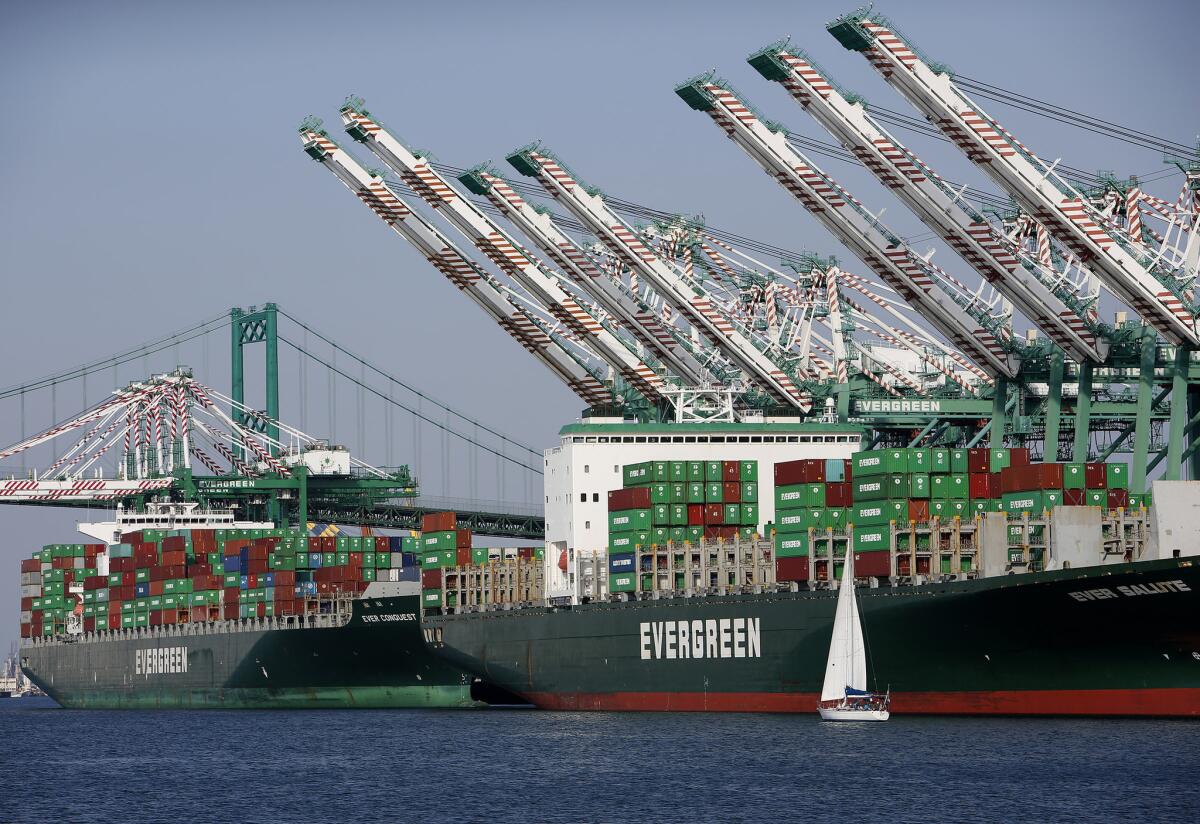Economy contracted 0.7% in the first quarter; corporate profits fall

Ships sit loaded with cargo at the Evergreen yard in San Pedro in February.
- Share via
Reporting from Washington — The economy performed worse than initially estimated in the first quarter, contracting for just the third time since the Great Recession as severe weather, a West Coast ports dispute and the soaring U.S. dollar smothered growth.
It was the second straight year that the economy shrank in the first quarter, raising questions about how the government adjusts its data for seasonal fluctuations.
Total economic output, also known as gross domestic product, decreased at a 0.7% annual rate from January through March, the Commerce Department said Friday.
In its initial estimate last month, the government said the economy expanded at a 0.2% annual rate. That was a sharp decline from the 2.2% annualized growth in the fourth quarter.
Additional data since then, particularly a dramatic widening in the trade deficit in March, led many economists to forecast the Commerce Department would revise its figures to show the economy actually contracted.
Two consecutive quarterly contractions generally signal a recession.
But economists aren’t worried about another recession, noting temporary factors and potential problems with seasonal adjustments in the data drove the first-quarter contraction. They expect growth to return in the second quarter, with the economy expanding at about a 2% annual rate.
Friday’s economic growth estimate, the second of three done each quarter, was in line with analysts’ expectations of a 0.8% contraction.
Economists have wondered if the economy really performed as badly as the figures seem to indicate.
They noted that the only three contractions since the Great Recession took place in the first quarters of the year and questioned if the Commerce Department was properly adjusting its estimates for seasonal changes.
The new first-quarter figure was the worst since the economy shrank 2.1% in the first three months of 2014, largely because of even more severe winter weather.
The downward revision for this year was caused by more imports than initially estimated and reductions in consumer spending and inventory investment by businesses, the Commerce Department said.
Imports surged in March because many container ships were delayed in unloading their cargo in the first two months of the year by a labor dispute at the ports of Los Angeles and Long Beach as well as elsewhere on the West Coast.
The rising value of the dollar against other currencies also made imports less expensive while increasing the costs for foreigners to purchase U.S. exports.
The dollar’s strength also hurt corporate profits.
The Commerce Department reported Friday that adjusted, pre-tax profits declined by $125.5 billion to $2 trillion in the first quarter. The 5.9% decrease from the previous quarter was the largest drop since 2008.
The downbeat data weighed on investors. The Dow Jones industrial average fell about 150 points, or about 0.8%, in early trading.
The White House sought to ease concerns about the economy.
“The first-quarter slowdown was the result of harsh winter weather, tepid foreign demand and consumers saving the windfall from lower oil prices,” said Jason Furman, chairman of the White House Council of Economic Advisors.
He cautioned against reading too much into one quarter’s data, noting that consumer spending and business investment were up 3.4% over the 12 months ended March 31 and that job growth has remained strong.
In addition, annualized economic growth has averaged 0.4% in the first quarter during the last decade, “considerably slower than the other three quarters,” Furman said.
Worsening weather might be a reason, he said.
“The seasonal adjustment process should remove the growth effects of ‘normal’ winter weather, but particularly harsh winters will still reduce seasonally adjusted output,” Furman said.
In response to questions about the accuracy of first quarter economic data, the Bureau of Economic Analysis, the Commerce Department division that calculates economic growth, said on May 20 that it would review how it applies so-called seasonal adjustments.
In a blog post, the bureau said changes in seasonal patterns could lead to what it called “residual seasonality” -- the continued influence of the patterns in data that already has been adjusted to take those into account.
Among the patterns in the first quarter of each year are the annual cutbacks in extra workers hired for the Christmas holiday season.
The announcement came after the Federal Reserve Bank of San Francisco said in a research report on May 18 that there was residual seasonality in the initial estimate of first-quarter growth.
“We conclude that there is a good chance the underlying economic growth so far this year was substantially stronger than reported,” the report said.
The San Francisco Fed researchers said that revising the seasonal adjustments of the BEA’s initial first-quarter estimate of 0.2% growth would have produced a 1.8% annual growth rate.
Ian Shepherdson, chief economist at Pantheon Macroeconomics, said he expected “a hefty upward revision” in the first-quarter data when the BEA applies revisions in July based on its review of seasonal adjustments.
Follow @JimPuzzanghera on Twitter
More to Read
Inside the business of entertainment
The Wide Shot brings you news, analysis and insights on everything from streaming wars to production — and what it all means for the future.
You may occasionally receive promotional content from the Los Angeles Times.











